企业成本控制分析Word文档
企业成本控制分析word资料9页

COST CONTROLRoger J. AbiNaderReference for Business,Encyclopedia of Business, 2nd ed.Cost control, also known as cost management or cost containment, is a broad set of cost accountingmethods and management techniques with the common goal of improving business cost-efficiency by reducing costs, or at least restricting their rate of growth. Businesses use cost control methods to monitor, evaluate, and ultimately enhance the efficiency of specific areas, such as departments, divisions, or product lines, within their operations.During the 1990s cost control initiatives received paramount attention from corporate America. Often taking the form of corporate restructuring, divestmentof peripheral activities, mass layoffs,or outsourcing,cost control strategies were seen as necessary to preserve—or boost—corporate profits and to maintain—or gain—a competitive advantage. The objective was often to be the low-cost producer in a given industry, which would typically allow the company to take a greater profit per unit of sales than its competitors at a given price level.Some cost control proponents believe that such strategic cost-cutting must be planned carefully, as not all cost reduction techniques yield the same benefits. In a notable late 1990s example,chief executive Albert J. Dunlap, nicknamed "Chainsaw Al" because of his penchant for deep cost cutting at the companies he headed, failed to restore the ailing small appliance maker Sunbeam Corporation to profitability despite his drastic cost reduction tactics. Dunlap laid off thousands of workers and sold off business units, but made little contribution to Sunbeam's competitive position or share price in his two years as CEO. Consequently, in 1998 Sunbeam's board fired Dunlap, having lost confidence in his "one-trick" approach to management.Behavioral management deals with the attitudes and actions of employees. While employee behavior ultimately impacts on success, behavioral management involves certain issues and assumptions not applicable to accounting's control function. On the other hand, performance evaluation measures outcomes of employee's actions by comparing the actual results of business outcomes to predetermined standards of success. In this way management identifies the strengths it needs to maximize, and the weaknesses it seeks to rectify. This process of evaluation and remedy is called cost control.Cost control is a continuous process that begins with the proposed annual budget. The budget helps: (1) to organize and coordinate production, and the selling, distribution, service, andadministrative functions; and (2) to take maximum advantage of available opportunities. As the fiscal year progresses, management compares actual results with those projected in the budget and incorporates into the new plan the lessons learned from its evaluation of current operations.Control refers to management's effort to influence the actions of individuals who are responsible for performing tasks, incurring costs, and generating revenues. Management is a two-phased process: planningrefers to the way that management plans and wants people to perform, while controlrefers to the procedures employed to determine whether actual performance complies with these plans. Through the budget process and accounting control, management establishes overall company objectives, defines the centers of responsibility, determines specific objectives for each responsibility center, and designs procedures and standards for reporting and evaluation.A budget segments the business into its components or centers where the responsible party initiates and controls action. Responsibility centersrepresent applicable organizational units, functions, departments, and divisions. Generally a single individual heads the responsibility center exercising substantial, if not complete, control over the activities of people or processeswithin the center and controlling the results of their activity. Cost centersare accountable only for expenses, that is, they do not generate revenue. Examples include accounting departments, human resources departments, and similar areas of the business that provide internal services. Profit centersaccept responsibility for both revenue and expenses. For example, a product line or an autonomous business unit might be considered profit centers. If the profit center has its own assets, it may also be considered an investment center,for which returns on investment can be determined. The use of responsibility centers allows management to design control reports to pinpoint accountability, thus aiding in profit planning.A budget also sets standards to indicate the level of activity expected from each responsible person or decision unit, and the amount of resources that a responsible party should use in achieving that level of activity. A budget establishes the responsibility center, delegates the concomitant responsibilities, and determines the decision points within an organization.The planning process provides for two types of control mechanisms:Feedforward: providing a basis for control at the point of action (the decision point); andFeedback: providing a basis for measuring the effectiveness of control after implementation.Management's role is to feedforwarda futuristic vision of where the company is going and how it is to get there, and to make clear decisions coordinating and directing employee activities. Management also oversees the development of procedures to collect, record, and evaluate feedback.Therefore, effective management controls results from leading people by force of personality and through persuasion; providing and maintaining proper training, planning, and resources; and improving quality and results through evaluation and feedback.Control reports are informational reports that tell management about an entity's activities. Management requests control reports only for internal use, and, therefore, directs the accounting department to develop tailor-made reporting formats. Accounting provides management with a format designed to detect variations that need investigating. In addition, management also refers to conventional reports such as the income statement and funds statement, and external reports on the general economy and the specific industry.Control reports, then, need to provide an adequate amount of information so that management may determine the reasons for anycost variances from the original budget. A good control report highlights significant information by focusing management's attention on those items in which actual performance significantly differs from the standard.Because key success factors shift in type and number, accounting revises control reports when necessary. Accounting also varies the control period covered by the control report to encompass a period in which management can take useful remedial action. In addition, accounting disseminates control reports in a timely fashion to give management adequate time to act before the issuance of the next report.Managers perform effectively when they attain the goals and objectives set by the budget. With respect to profits, managers succeed by the degree to which revenues continually exceed expenses. In applying the following simple formula, managers, especially those in operations, realize that they exercise more control over expenses than they do over revenue.While they cannot predict the timing and volume of actual sales, they can determine the utilization rate of most of their resources, that is, they can influence the cost side. Hence, the evaluation of management's performance and its operations is cost control.For cost control purposes, a budget provides standard costs.As management constructs budgets, it lays out a road map to guide its efforts. It states a number of assumptions about the relationships and interaction among the economy, market dynamics, the abilities of its sales force, and its capacity to provide the proper quantity and quality of products demanded.Accounting plays a key role in all planning and control. It does this in four key areas: (1) data collection, (2) data analysis, (3) budget control and administration, and (4) consolidation and review.The accountants play a key role in designing and securing support for the procedural aspects of the planning process. In addition, they design and distribute forms for the collection and booking of detailed data on all aspects of the business.Although operating managers have the main responsibility of planning, accounting compiles and coordinates the elements. Accountants subject proposed budgets to feasibility and profitability analyses to determine conformity to accepted standards and practices.Management relies on such accounting data and analysis to choose from several cost control alternatives, or management may direct accounting to prepare reports specifically for evaluating such options. As the Chainsaw Al episode indicated, all costs may notbe viable targets for cost-cutting measures. For instance, in mass layoffs, the company may lose a significant share of its human capitalby releasing veteran employees who are experts in their fields, not to mention by creating a decline in morale among those who remain. Thus management must identify which costs have strategic significance and which do not.To determine the strategic impact of cost-cutting, management has to weigh the net effects of the proposed change on all areas of the business. For example, reducing variable costs related directly to manufacturing a product, such as materials and transportation costs, could be the key to greater incremental profits. However, management must also consider whether saving money on production is jeopardizing other strategic interests like quality or time to market. If a cheaper material or transportation system negatively impacts other strategic variables, the nominal cost savings may not benefit the company in the bigger picture, e.g., it may lose sales. In such scenarios, managers require the discipline not to place short-term savings over long-term interests.One trend in cost control has been toward narrowing the focus of corporate responsibility centers, and thereby shifting some of the cost control function to day-to-day managers who have the mostknowledge of and influence over how their areas spend money. This practice is intended to promote bottom-up cost control measures and encourage a widespread consensus over cost management strategies.Control of the business entity, then, is essentially a managerial and supervisory function. Control consists of those actions necessary to assure that the entity's resources and operations are focused on attaining established objectives, goals and plans. Control, exercised continuously, flags potential problems so that crises may be prevented. It also standardizes the quality and quantity of output, and provides managers with objective information about employee performance. Management compares actual performance to predetermined standards and takes action when necessary to correct variances from the standards.希望以上资料对你有所帮助,附励志名言3条:1、常自认为是福薄的人,任何不好的事情发生都合情合理,有这样平常心态,将会战胜很多困难。
成本分析 Microsoft Word 文档

413项目威尼斯庄园主体成本盈亏分析自2010年7月份开工至2011年6月底,我项目施工的威尼斯庄园2#、3#楼主体施工已经完毕。
因此本工程有必要进行主体阶段综合的经济评价。
威尼斯盈亏分析主要从理论分析和实际数据两方面入手,对亏损或盈利的原因进行深入的分析,对经营收入和成本的详细构成进行深入分析并进行对比,找出盈亏在哪些方面,各是多少。
这对以后改进管理方法、指导项目工作具有重要意义。
并能提高经济效益,使利润最大化。
一、两算对比数据:本工程为I类工程,税前让利7%,执行03定额,08枣庄价目表。
人工单价40元/工日,建筑面积65000m2,主体完成后付款至已完工程量的75%。
截止6月底威尼斯庄园完成产值49791320元,实际成本支出43720330元,扣除税金1670851元,加上签证150000元,材料盘存200000元,固定资产折旧费300000元,实际收入和成本对比如下表:(表1)由上表可以看出,本工程截至主体阶段,扣除让利、税金、贷款利息后实际利润为总产值的10.1%。
以下详细分析利润来源以及各方面节超原因。
(表2)(1)、人工费分析把企业管理费合并到人工费中分析,主要原因是实际施工中发生的人工费基本涵盖了企业管理费中所含的内容,二者在实际施工中不易区分,放在一起分析即符合实际,直观效果也比较好。
由上表可知道,人工费超出23%。
本工程定额工日为40元/天,但是按目前市场价格,三大工种木工、瓦工、钢筋工全部超过100元/天,高者甚至超过200元/天。
虽然定额人工费是按照8小时编制的,我们实际工人干活时间一般在10个小时以上,但是即使把定额工作时间翻一倍,达到80元/工日,也不足以弥补实际人工费与定额人工费单价之间的巨大差距。
所以人工费亏损是行业现象,不是单个工程的问题。
(2)、材料费的分析工程中,材料费比重最大,占到总造价的60%-70%,因此材料控制的好坏直接影响着工程经济效益的好坏。
本工程材料费结余13.4%,相比于人工费比较固定,材料费的变化比较大,一些材料在定额中的损耗系数也比较高,控制好了完全可以把结余系数控制在一个较高的范围内,本工程主要采取以下几种措施增加材料结余:1.采购时,货比三家,选取质优价廉的材料,通过和甲方限价单的价格差价增加一些利润。
(完整word版)企业成本分析说明及相关证明材料

企业成本分析说明及相关证明材料一、前言非常荣幸有机会参加本工程项目的投标,能承接本工程是我司的愿望。
若有幸承接本项目的施工,在为服务建设单位的同时,也在为我公司带来良好的经济效益和社会效益。
为此我公司将发扬“一次建成用户满意品质工程”的工作精神,把本工程作为我公司一个企业创信誉、树形象的窗口工程,并且将该项目列入公司重点创优名牌工程,作为我公司的重点项目来对待,同时借此工程项目展示我公司能工巧匠的精湛技艺,树立我公司施工一流的企业形象。
二、成本分析接到本项目的招标资料后,我公司经营管理部门组织专业人员到实际施工地点进行了深入勘察,在结合我公司现有的企业综合实力情况下,本着我公司“保本微利”的业务经营原则,经公司高层领导同意,决定本项目以投标最高限价下浮24.5%的报价进行竞争性投标。
投标报价存在经营风险,但本次投标报价这个风险对我公司来说是属于可控制范围,虽说我公司的报价低于招标文件中所说的最高限价80%,但经测算是不低于我公司真正的企业成本价,总体来说主要是这几个方面来保障:1、前期我公司已派专人深入了解本项目的实际情况,包括周边环境特点,为我公司专业人员测算本工程的成本价提供了真实可靠的依据。
2、我公司在本项目施工地点附近有在建项目,如:文华路污水干管工程(丰收涌至石角泵站)、劳动力、机械设备可从附近调遣过来,减少二次搬运,节省了成本。
3、本工程工期较短,我公司可在施工现场仅设置现场材料堆放场及办公临设,生活临设可利用我公司附近完工待验收项目那边的项目部进行合理安排处理,节省了企业开支。
4、经过多年在佛山的创业与发展,我公司与周边材料供应商的关系一直比较好,在相关建筑材料供应商圈子中口碑较好,这一点可保证材料得到及时供应及可以得到更优惠合理的材料供应报价,使我公司可以获得更大的竞争优势。
5、经过多年在佛山的创业与发展,我公司在佛山各工地均陆续购有相关施工机械设备,本工程所需的关键机械设备我公司均自有,节省了租赁的中间环节,节省了企业成本。
企业财务管理中的成本控制分析
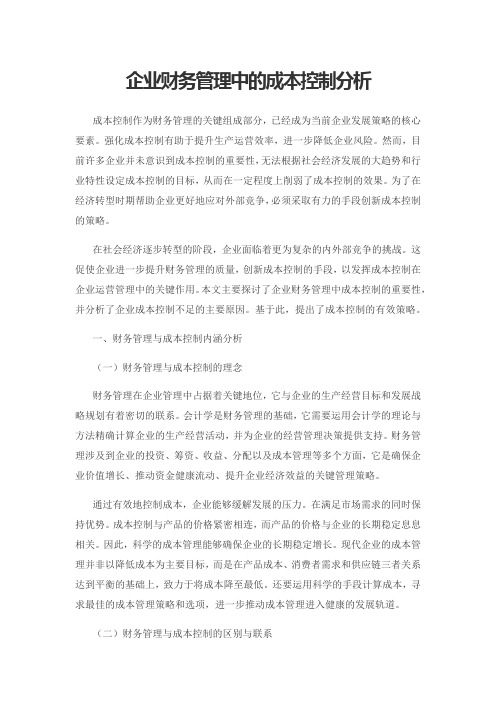
企业财务管理中的成本控制分析成本控制作为财务管理的关键组成部分,已经成为当前企业发展策略的核心要素。
强化成本控制有助于提升生产运营效率,进一步降低企业风险。
然而,目前许多企业并未意识到成本控制的重要性,无法根据社会经济发展的大趋势和行业特性设定成本控制的目标,从而在一定程度上削弱了成本控制的效果。
为了在经济转型时期帮助企业更好地应对外部竞争,必须采取有力的手段创新成本控制的策略。
在社会经济逐步转型的阶段,企业面临着更为复杂的内外部竞争的挑战。
这促使企业进一步提升财务管理的质量,创新成本控制的手段,以发挥成本控制在企业运营管理中的关键作用。
本文主要探讨了企业财务管理中成本控制的重要性,并分析了企业成本控制不足的主要原因。
基于此,提出了成本控制的有效策略。
一、财务管理与成本控制内涵分析(一)财务管理与成本控制的理念财务管理在企业管理中占据着关键地位,它与企业的生产经营目标和发展战略规划有着密切的联系。
会计学是财务管理的基础,它需要运用会计学的理论与方法精确计算企业的生产经营活动,并为企业的经营管理决策提供支持。
财务管理涉及到企业的投资、筹资、收益、分配以及成本管理等多个方面,它是确保企业价值增长、推动资金健康流动、提升企业经济效益的关键管理策略。
通过有效地控制成本,企业能够缓解发展的压力。
在满足市场需求的同时保持优势。
成本控制与产品的价格紧密相连,而产品的价格与企业的长期稳定息息相关。
因此,科学的成本管理能够确保企业的长期稳定增长。
现代企业的成本管理并非以降低成本为主要目标,而是在产品成本、消费者需求和供应链三者关系达到平衡的基础上,致力于将成本降至最低。
还要运用科学的手段计算成本,寻求最佳的成本管理策略和选项,进一步推动成本管理进入健康的发展轨道。
(二)财务管理与成本控制的区别与联系财务管理和成本控制之间存在着互有差异又相互关联的关系,它们的涵盖范围也有所不同。
财务管理的覆盖面更广,而成本控制的实施更为精细和专业,具有明确的方向性,并且积累了许多值得借鉴的丰富经验。
(完整word版)企业成本分析说明及相关证明材料
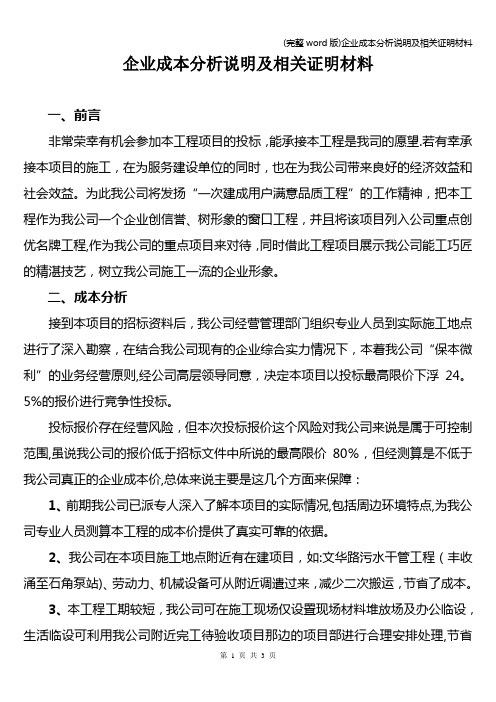
企业成本分析说明及相关证明材料一、前言非常荣幸有机会参加本工程项目的投标,能承接本工程是我司的愿望.若有幸承接本项目的施工,在为服务建设单位的同时,也在为我公司带来良好的经济效益和社会效益。
为此我公司将发扬“一次建成用户满意品质工程”的工作精神,把本工程作为我公司一个企业创信誉、树形象的窗口工程,并且将该项目列入公司重点创优名牌工程,作为我公司的重点项目来对待,同时借此工程项目展示我公司能工巧匠的精湛技艺,树立我公司施工一流的企业形象。
二、成本分析接到本项目的招标资料后,我公司经营管理部门组织专业人员到实际施工地点进行了深入勘察,在结合我公司现有的企业综合实力情况下,本着我公司“保本微利”的业务经营原则,经公司高层领导同意,决定本项目以投标最高限价下浮24。
5%的报价进行竞争性投标。
投标报价存在经营风险,但本次投标报价这个风险对我公司来说是属于可控制范围,虽说我公司的报价低于招标文件中所说的最高限价80%,但经测算是不低于我公司真正的企业成本价,总体来说主要是这几个方面来保障:1、前期我公司已派专人深入了解本项目的实际情况,包括周边环境特点,为我公司专业人员测算本工程的成本价提供了真实可靠的依据。
2、我公司在本项目施工地点附近有在建项目,如:文华路污水干管工程(丰收涌至石角泵站)、劳动力、机械设备可从附近调遣过来,减少二次搬运,节省了成本。
3、本工程工期较短,我公司可在施工现场仅设置现场材料堆放场及办公临设,生活临设可利用我公司附近完工待验收项目那边的项目部进行合理安排处理,节省了企业开支。
4、经过多年在佛山的创业与发展,我公司与周边材料供应商的关系一直比较好,在相关建筑材料供应商圈子中口碑较好,这一点可保证材料得到及时供应及可以得到更优惠合理的材料供应报价,使我公司可以获得更大的竞争优势.5、经过多年在佛山的创业与发展,我公司在佛山各工地均陆续购有相关施工机械设备,本工程所需的关键机械设备我公司均自有,节省了租赁的中间环节,节省了企业成本。
企业成本核算分析(6篇)-成本核算论文-会计论文
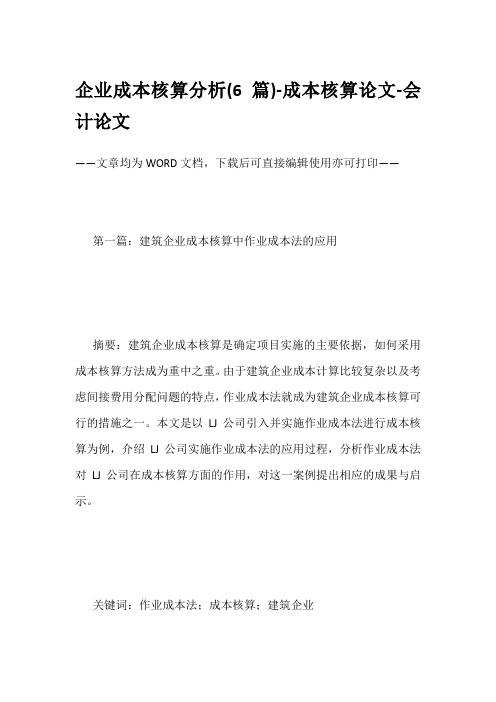
企业成本核算分析(6篇)-成本核算论文-会计论文——文章均为WORD文档,下载后可直接编辑使用亦可打印——第一篇:建筑企业成本核算中作业成本法的应用摘要:建筑企业成本核算是确定项目实施的主要依据,如何采用成本核算方法成为重中之重。
由于建筑企业成本计算比较复杂以及考虑间接费用分配问题的特点,作业成本法就成为建筑企业成本核算可行的措施之一。
本文是以LJ公司引入并实施作业成本法进行成本核算为例,介绍LJ公司实施作业成本法的应用过程,分析作业成本法对LJ公司在成本核算方面的作用,对这一案例提出相应的成果与启示。
关键词:作业成本法;成本核算;建筑企业一、简介LJ公司及其作业成本法实施案例LJ公司主营业务为公路、桥梁施工,这家公司目前的成本核算非常单一,只是在一定范围内进行简单的核算,对于成本的准确性把握不够。
随着公司的不断壮大,这种简便的算法已经不能满足公司需要,如果不找到一条可行之路,公司的状况只会每况愈下,对于公司的发展目标也会造成阻碍。
因此,企业需要提出一个目标选择,为公司的长远做准备,作业成本法应运而生,能够解决企业目前的困境,精细化的成本核算为公司发展提供帮助。
为了改善LJ公司成本核算中资源配置出现的问题,我们以公司桥梁项目为例,并实施作业成本核算体系。
根据LJ公司的工程项目的作业特点,桥梁项目单项工程可以分解为基础挖方及回填、结构混凝土工程、桥梁支座和伸缩装置等若干单位工程。
组成单位工程的就是分部工程,桥梁项目的建筑工程可以分解为基础、主体结构和桥面等若干分部工程。
组成分部工程的是分项工程,桥梁项目的钢筋混凝土工程可以分解为模板、钢筋和混凝土等若干分项工程。
下面以LJ公司工程项目的土建阶段为例进行WBS分解,分解为地基与基础工程、主体结构工程、装饰装修工程和层面工程等四项,WBS分解的最后一级就是各项作业中心,如桥梁项目主体结构阶段的木胶板、钢筋、商砼、灯座、回填土工程等都是土建工程的最后一级(各项作业中心)。
企业成本控制分析报告
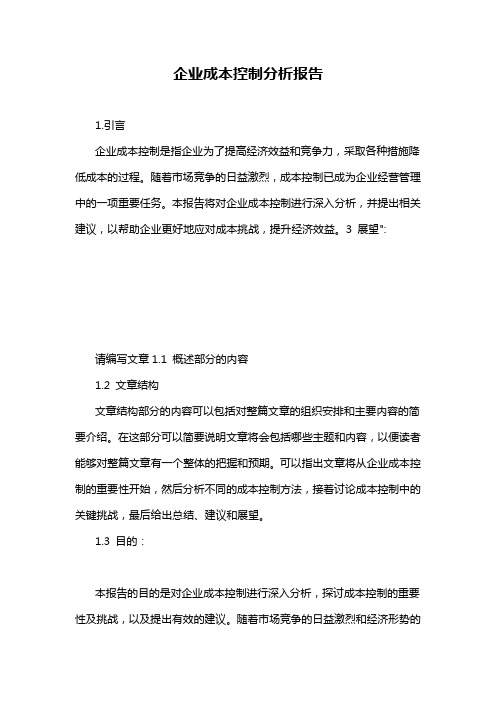
企业成本控制分析报告1.引言企业成本控制是指企业为了提高经济效益和竞争力,采取各种措施降低成本的过程。
随着市场竞争的日益激烈,成本控制已成为企业经营管理中的一项重要任务。
本报告将对企业成本控制进行深入分析,并提出相关建议,以帮助企业更好地应对成本挑战,提升经济效益。
3 展望":请编写文章1.1 概述部分的内容1.2 文章结构文章结构部分的内容可以包括对整篇文章的组织安排和主要内容的简要介绍。
在这部分可以简要说明文章将会包括哪些主题和内容,以便读者能够对整篇文章有一个整体的把握和预期。
可以指出文章将从企业成本控制的重要性开始,然后分析不同的成本控制方法,接着讨论成本控制中的关键挑战,最后给出总结、建议和展望。
1.3 目的:本报告的目的是对企业成本控制进行深入分析,探讨成本控制的重要性及挑战,以及提出有效的建议。
随着市场竞争的日益激烈和经济形势的不确定性,企业需要不断寻求成本控制的方法,以确保经营的健康和可持续发展。
通过本报告的研究和分析,旨在为企业管理者提供更多关于成本控制的理论知识和实践经验,帮助他们更好地制定成本控制策略,提高企业的竞争力和盈利能力。
2.正文2.1 企业成本控制的重要性企业成本控制是企业经营管理过程中至关重要的一环。
首先,成本控制直接影响到企业的盈利能力。
在如今激烈的市场竞争中,企业需要不断降低生产成本,提高产品竞争力,才能在市场中占据一席之地。
其次,成本控制也是企业持续发展的基础。
如果企业不能有效控制成本,就会面临盈利能力下降、资金紧张等问题,最终可能导致企业倒闭。
另外,成本控制还能提高企业的抗风险能力。
当市场发生变化、价格波动等外部风险时,成本控制能够降低企业受到的冲击,增强企业的抵御能力。
因此,企业成本控制不仅对企业的日常经营有重要意义,也是企业可持续发展的关键。
2.2 成本控制方法分析:成本控制是企业管理中非常重要的一个环节,通过有效的控制成本,企业能够提高盈利能力,增强竞争力。
企业成本控制分析
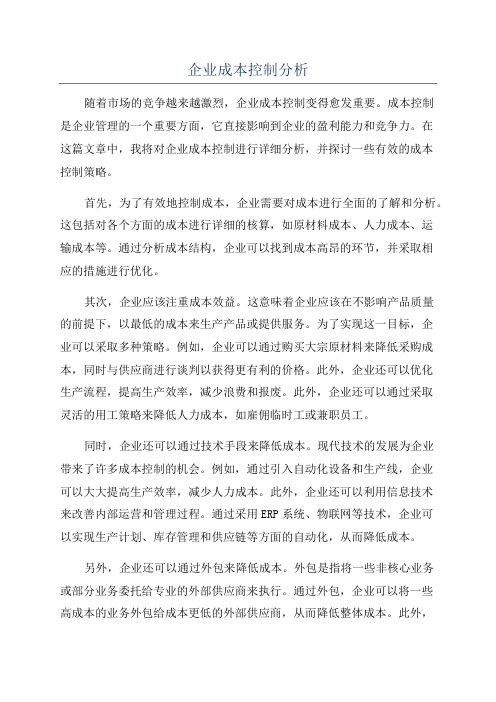
企业成本控制分析随着市场的竞争越来越激烈,企业成本控制变得愈发重要。
成本控制是企业管理的一个重要方面,它直接影响到企业的盈利能力和竞争力。
在这篇文章中,我将对企业成本控制进行详细分析,并探讨一些有效的成本控制策略。
首先,为了有效地控制成本,企业需要对成本进行全面的了解和分析。
这包括对各个方面的成本进行详细的核算,如原材料成本、人力成本、运输成本等。
通过分析成本结构,企业可以找到成本高昂的环节,并采取相应的措施进行优化。
其次,企业应该注重成本效益。
这意味着企业应该在不影响产品质量的前提下,以最低的成本来生产产品或提供服务。
为了实现这一目标,企业可以采取多种策略。
例如,企业可以通过购买大宗原材料来降低采购成本,同时与供应商进行谈判以获得更有利的价格。
此外,企业还可以优化生产流程,提高生产效率,减少浪费和报废。
此外,企业还可以通过采取灵活的用工策略来降低人力成本,如雇佣临时工或兼职员工。
同时,企业还可以通过技术手段来降低成本。
现代技术的发展为企业带来了许多成本控制的机会。
例如,通过引入自动化设备和生产线,企业可以大大提高生产效率,减少人力成本。
此外,企业还可以利用信息技术来改善内部运营和管理过程。
通过采用ERP系统、物联网等技术,企业可以实现生产计划、库存管理和供应链等方面的自动化,从而降低成本。
另外,企业还可以通过外包来降低成本。
外包是指将一些非核心业务或部分业务委托给专业的外部供应商来执行。
通过外包,企业可以将一些高成本的业务外包给成本更低的外部供应商,从而降低整体成本。
此外,企业还可以通过与供应商和合作伙伴建立长期合作关系来降低成本。
通过与供应商进行战略合作,企业可以获得更好的价格和服务,并且可以共同开发新的产品或解决方案。
最后,企业应该注重成本管理和监控。
成本控制并不是一次性的工作,而是一个持续的过程。
企业应该建立完善的成本管理和监控机制。
这包括建立成本核算体系、制定成本控制指标、建立成本预算等。
- 1、下载文档前请自行甄别文档内容的完整性,平台不提供额外的编辑、内容补充、找答案等附加服务。
- 2、"仅部分预览"的文档,不可在线预览部分如存在完整性等问题,可反馈申请退款(可完整预览的文档不适用该条件!)。
- 3、如文档侵犯您的权益,请联系客服反馈,我们会尽快为您处理(人工客服工作时间:9:00-18:30)。
COST CONTROLRoger J. AbiNaderReference for Business,Encyclopedia of Business, 2nd ed.Cost control, also known as cost management or cost containment, is a broad set of cost accountingmethods and management techniques with the common goal of improving business cost-efficiency by reducing costs, or at least restricting their rate of growth. Businesses use cost control methods to monitor, evaluate, and ultimately enhance the efficiency of specific areas, such as departments, divisions, or product lines, within their operations.During the 1990s cost control initiatives received paramount attention from corporate America. Often taking the form of corporate restructuring, divestmentof peripheral activities, mass layoffs,or outsourcing,cost control strategies were seen as necessary to preserve—or boost—corporate profits and to maintain—or gain—a competitive advantage. The objective was often to be the low-cost producer in a given industry, which would typically allow the company to take a greater profit per unit of sales than its competitors at a given price level.Some cost control proponents believe that such strategic cost-cutting must be planned carefully, as not all cost reduction techniques yield the same benefits. In a notable late 1990s example, chief executive Albert J. Dunlap, nicknamed "Chainsaw Al" because of his penchant for deep cost cutting at the companies he headed, failed to restore the ailing small appliance maker Sunbeam Corporation to profitability despite his drastic cost reduction tactics. Dunlap laid off thousands of workers and sold off business units, but made little contribution to Sunbeam's competitive position or share price in his two years as CEO. Consequently, in 1998 Sunbeam's board fired Dunlap, having lost confidence in his "one-trick" approach to management.Behavioral management deals with the attitudes and actions of employees. While employee behavior ultimately impacts on success, behavioral management involves certain issues and assumptions not applicable to accounting's control function. On the other hand, performance evaluation measures outcomes of employee's actions by comparing the actual results of business outcomes to predetermined standards of success. In this way management identifies the strengths it needs to maximize, and the weaknesses it seeks to rectify. This process of evaluation and remedy is called cost control.Cost control is a continuous process that begins with the proposed annual budget. The budget helps: (1) to organize and coordinate production, and the selling, distribution, service, and administrative functions; and (2) to take maximum advantage of available opportunities. As the fiscal year progresses, management compares actual results with those projected in the budget and incorporates into the new plan the lessons learned from its evaluation of current operations.Control refers to management's effort to influence the actions of individuals who are responsible for performing tasks, incurring costs, and generating revenues. Management is a two-phased process: planningrefers to the way that management plans and wants people to perform, while controlrefers to the procedures employed to determine whether actual performance complies with these plans. Through the budget process and accounting control, management establishes overall company objectives, defines the centers of responsibility, determines specific objectives for each responsibility center, and designs procedures and standards for reporting and evaluation.A budget segments the business into its components or centers where the responsible party initiates and controls action. Responsibility centersrepresent applicable organizational units, functions, departments, and divisions. Generally a single individual heads the responsibility center exercising substantial, if not complete, control over the activities of people or processes within the center and controlling the results of their activity. Cost centersare accountable only for expenses, that is, they do not generate revenue. Examples include accounting departments, human resources departments, and similar areas of the business that provide internal services. Profit centersaccept responsibility for both revenue and expenses. For example, a product line or an autonomous business unit might be considered profit centers. If the profit center has its own assets, it may also be considered an investment center,for which returns on investment can be determined. The use of responsibility centers allows management to design control reports to pinpoint accountability, thus aiding in profit planning.A budget also sets standards to indicate the level of activity expected from each responsible person or decision unit, and the amount of resources that a responsible party should use in achieving that level of activity. A budget establishes the responsibility center, delegates the concomitant responsibilities, and determines the decision points within an organization.The planning process provides for two types of control mechanisms:Feedforward: providing a basis for control at the point of action (the decision point); andFeedback: providing a basis for measuring the effectiveness of control after implementation.Management's role is to feedforwarda futuristic vision of where the company is going and how it is to get there, and to make clear decisions coordinating and directing employee activities. Management also oversees the development of procedures to collect, record, and evaluate feedback.Therefore, effective management controls results from leading people by force of personality and through persuasion; providing and maintaining proper training, planning, and resources; and improving quality and results through evaluation and feedback.Control reports are informational reports that tell management about an entity's activities. Management requests control reports only for internal use, and, therefore, directs the accounting department to develop tailor-made reporting formats. Accounting provides management with a format designed to detect variations that need investigating. In addition, management also refers to conventional reports such as the income statement and funds statement, and external reports on the general economy and the specific industry.Control reports, then, need to provide an adequate amount of information so that management may determine the reasons for any cost variances from the original budget.A good control report highlights significant information by focusing management's attention on those items in which actual performance significantly differs from the standard.Because key success factors shift in type and number, accounting revises control reports when necessary. Accounting also varies the control period covered by the control report to encompass a period in which management can take useful remedial action. In addition, accounting disseminates control reports in a timely fashion to give management adequate time to act before the issuance of the next report.Managers perform effectively when they attain the goals and objectives set by the budget. With respect to profits, managers succeed by the degree to which revenues continually exceed expenses. In applying the following simple formula, managers, especially those in operations, realize that they exercise more control over expenses than they do over revenue.While they cannot predict the timing and volume of actual sales, they can determine the utilization rate of most of their resources, that is, they caninfluence the cost side. Hence, the evaluation of management's performance and its operations is cost control.For cost control purposes, a budget provides standard costs. As management constructs budgets, it lays out a road map to guide its efforts. It states a number of assumptions about the relationships and interaction among the economy, market dynamics, the abilities of its sales force, and its capacity to provide the proper quantity and quality of products demanded.Accounting plays a key role in all planning and control. It does this in four key areas: (1) data collection, (2) data analysis, (3) budget control and administration, and (4) consolidation and review.The accountants play a key role in designing and securing support for the procedural aspects of the planning process. In addition, they design and distribute forms for the collection and booking of detailed data on all aspects of the business.Although operating managers have the main responsibility of planning, accounting compiles and coordinates the elements. Accountants subject proposed budgets to feasibility and profitability analyses to determine conformity to accepted standards and practices.Management relies on such accounting data and analysis to choose from several cost control alternatives, or management may direct accounting to prepare reports specifically for evaluating such options. As the Chainsaw Al episode indicated, all costs may not be viable targets for cost-cutting measures. For instance, in mass layoffs, the company may lose a significant share of its human capitalby releasing veteran employees who are experts in their fields, not to mention by creating a decline in morale among those who remain. Thus management must identify which costs have strategic significance and which do not.To determine the strategic impact of cost-cutting, management has to weigh the net effects of the proposed change on all areas of the business. For example, reducing variable costs related directly to manufacturing a product, such as materials and transportation costs, could be the key to greater incremental profits. However, management must also consider whether saving money on production is jeopardizing other strategic interests like quality or time to market. If a cheaper material or transportation system negatively impacts other strategic variables, the nominal cost savings may not benefit the company in the bigger picture, e.g., it may lose sales. In such scenarios, managers require the discipline not to place short-term savings over long-term interests.One trend in cost control has been toward narrowing the focus of corporate responsibility centers, and thereby shifting some of the cost control function to day-to-day managers who have the most knowledge of and influence over how their areas spend money. This practice is intended to promote bottom-up cost control measures and encourage a widespread consensus over cost management strategies.Control of the business entity, then, is essentially a managerial and supervisory function. Control consists of those actions necessary to assure that the entity's resources and operations are focused on attaining established objectives, goals and plans. Control, exercised continuously, flags potential problems so that crises may be prevented. It also standardizes the quality and quantity of output, and provides managers with objective information about employee performance. Management compares actual performance to predetermined standards and takes action when necessary to correct variances from the standards.(注:素材和资料部分来自网络,供参考。
